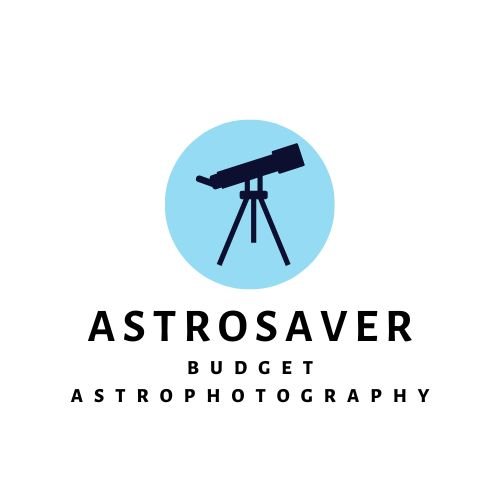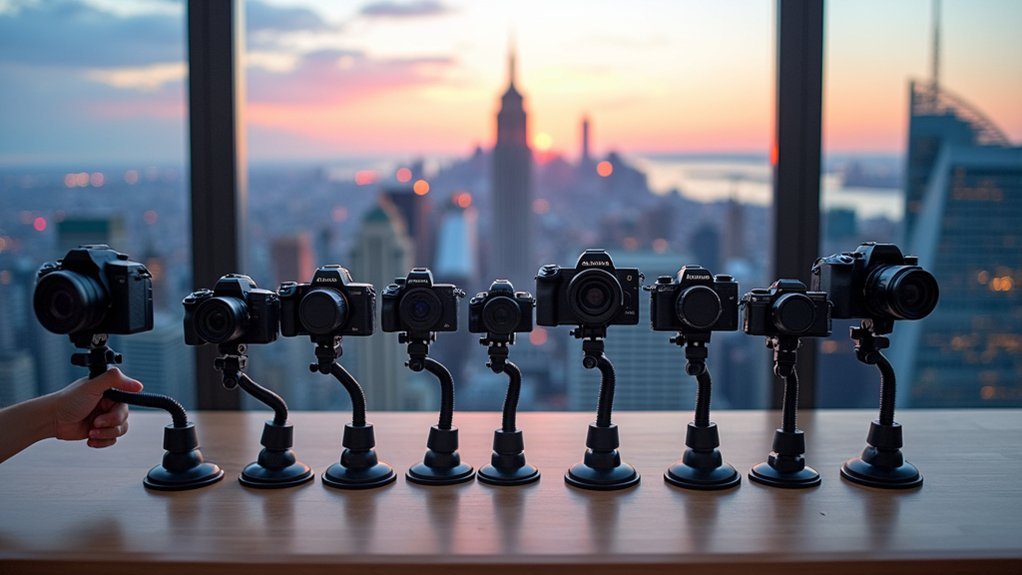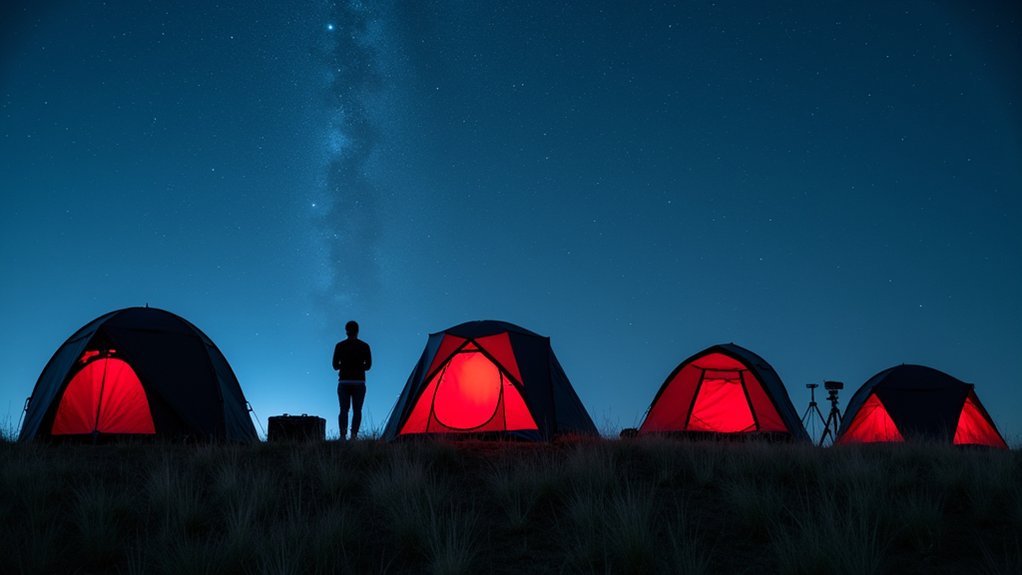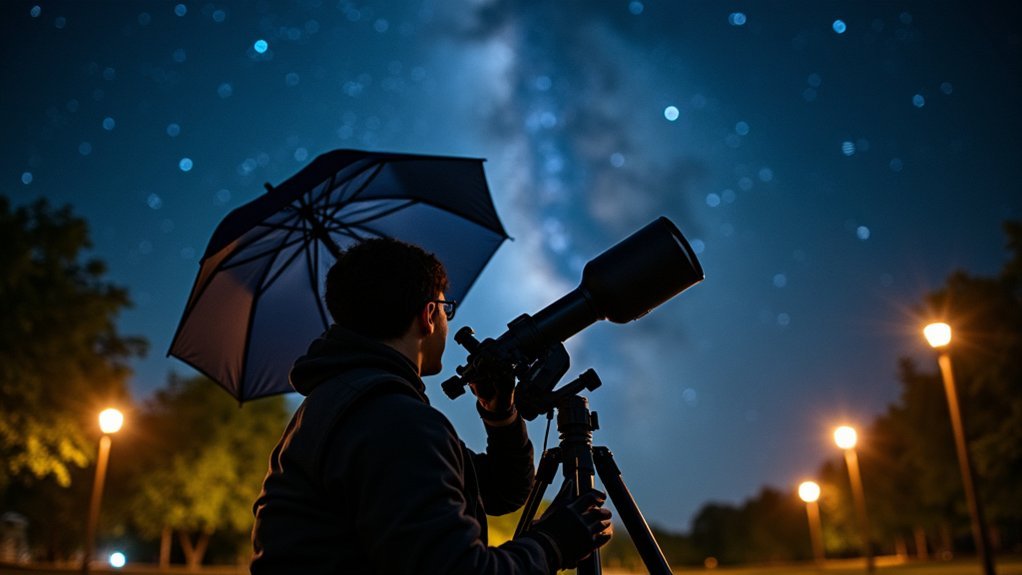Several free software options can remove dark frames from your astrophotography. DeepSkyStacker offers user-friendly automated stacking for beginners, while Siril provides powerful calibration scripts. Other options include SharpCap with real-time subtraction, ASTAP for efficient processing, PixInsight Trial for professional-grade tools, and RegiStax for planetary imaging. Each program balances automation and flexibility differently to enhance your final images. The detailed capabilities of each tool might surprise you.
What Free Software Removes Dark Frames From Astrophotography?

When capturing the night sky, unwanted noise can ruin your stellar images. Fortunately, several free software options can help with dark frame subtraction and noise reduction in your astrophotography images.
DeepSkyStacker (DSS) stands out as a popular choice that stacks dark frames alongside light and bias frames to create a Master Dark. This effectively reduces noise in your final image.
If you prefer real-time processing, Sharpcap allows for live dark frame subtraction during imaging sessions.
ImageJ and its enhanced variant Fiji provide versatile tools for creating and managing calibration frames in .fits format.
For a more automated approach, PHD can build a Master Dark library from your collected dark frame subs, streamlining your workflow and improving image quality.
Understanding Dark Frame Subtraction in Astrophotography
Although astrophotography captures the beauty of celestial objects, it also records unwanted noise that can diminish image quality.
Dark frame subtraction addresses this by removing thermal noise generated by your camera sensor during long exposures.
You’ll need to capture 10-15 dark frames (20+ recommended) using identical exposure settings as your light frames. These frames are then combined into a master dark frame that represents the camera’s noise pattern.
Software for stacking like DeepSkyStacker, PHD, and Sharpcap can automate this astrophotography image processing step.
Modern astrophotography software automates dark frame subtraction, saving time while dramatically improving final image quality.
For peak noise reduction, verify your dark frames match the temperature and ISO of your light frames.
Consider updating your dark frame library every 6-12 months to accommodate sensor aging and environmental changes.
This systematic approach greatly enhances the quality of your final astronomical images.
DeepSkyStacker: The Beginner’s Choice for Dark Frame Processing

DeepSkyStacker offers you powerful yet accessible dark frame processing features that remove unwanted noise from your astrophotography images.
You’ll find its automated frame calibration system intuitively handles dark, flat, and bias frames to create cleaner final images with improved signal-to-noise ratios.
The software’s ability to stack multiple dark frames into a Master Dark gives your astrophotography a professional quality that would otherwise require expensive programs.
DeepSkyStacker Processing Features
For beginners stepping into the world of astrophotography, dark frame processing often presents a formidable challenge. DeepSkyStacker (DSS) simplifies this complex task with automated features that seamlessly integrate dark frames into your image processing workflow.
You’ll find the software excels at creating master dark frames from your sub-exposures, which dramatically reduce noise in your final astrophotography images.
DSS offers recommended settings that make calibration approachable while delivering professional results. The stacking software efficiently manages your dark, light, and bias frames in an organized system that keeps your projects on track.
With support for multiple file formats and powerful alignment capabilities, you can focus on capturing the night sky while DSS handles the technical aspects of combining and enhancing your frames.
Automated Frame Calibration
When diving into astronomical imaging, you’ll find that automated frame calibration represents one of DeepSkyStacker’s most valuable features for newcomers. This free stacking software simplifies the complex process of dark frame subtraction with an intuitive interface that guides you through each step.
You’ll achieve ideal results by following DeepSkyStacker’s recommendation to use at least 20 dark frames, which greatly boosts your final signal-to-noise ratio. The software efficiently creates master dark frames that you can reuse across multiple astrophotography projects, saving considerable time.
The batch processing capability lets you handle numerous frames simultaneously, making your workflow more efficient.
Whether you’re just starting or advancing your skills, DeepSkyStacker’s automated calibration tools remove the technical barriers that might otherwise discourage beginners from achieving clean, noise-reduced astronomical images.
Siril: Open-Source Power for Advanced Calibration
Siril’s Calibration Script Wizards will guide you through the entire process of dark frame subtraction with step-by-step instructions that simplify complex astrophotography workflows.
You’ll appreciate Siril’s cross-platform compatibility, allowing you to process your celestial images on Windows, Mac, or Linux without compromising on features or performance.
The software seamlessly integrates calibration with its powerful stacking workflow, enabling you to move from raw frames to finished deep-sky images within a single application.
Calibration Script Wizards
Three critical calibration steps become effortless with Siril’s script wizard functionality.
You’ll find that applying dark frames, flats, and bias frames happens systematically through an intuitive interface that eliminates guesswork. The automation capabilities let you create calibration sequences that handle noise reduction consistently across multiple imaging sessions.
Siril’s user-friendly interface makes astrophotography calibration accessible even if you’re new to the process. The wizard walks you through each step, ensuring your images receive proper treatment to enhance detail and minimize artifacts.
You can save your calibration workflows as scripts, allowing you to apply identical processes to future imaging sessions with just a few clicks. This consistency is invaluable when processing multiple nights of data in various file formats, including .fits, which is common among serious astrophotographers.
Cross-Platform Compatibility
Unlike proprietary alternatives that limit your operating system choices, Siril breaks down technical barriers by offering true cross-platform compatibility across Windows, macOS, and Linux environments.
This accessibility means you’re never restricted by your operating system when removing dark frames from your astrophotography images.
Siril’s user-friendly interface maintains consistency across all platforms, ensuring you’ll navigate the stacking process with ease regardless of which system you’re using.
The software handles various image formats including RAW and FITS, giving you flexibility when processing your astronomical data.
This cross-platform approach doesn’t compromise Siril’s powerful calibration capabilities—you’ll still effectively eliminate noise using dark frames, bias frames, and flat frames while benefiting from precise image alignment tools that greatly enhance your final images.
Stacking Workflow Integration
When processing deep-sky images, you’ll find that Siril seamlessly integrates dark frame subtraction into an extensive stacking workflow that dramatically improves your final results.
This open-source astrophotography software streamlines the entire calibration process while maintaining professional-grade noise reduction capabilities.
Siril’s thorough workflow includes:
- Automated calibration frame application – efficiently processes dark frames, flat frames, and bias frames in a single operation
- Enhanced signal-to-noise ratio – systematically removes thermal noise patterns that diminish image quality
- Batch processing support – saves time by applying identical dark frame subtraction to multiple images
- Customizable stacking algorithms – lets you fine-tune the calibration process based on your specific imaging conditions
As a free solution, Siril delivers advanced capabilities that rival premium alternatives, making sophisticated astrophotography processing accessible to everyone.
ASTAP: Fast and Efficient Dark Frame Removal
Among the standout features of ASTAP (Astrometric Solver and Astrophotography) is its remarkable dark frame removal capability. This free software processes your astro photography images with impressive speed, efficiently eliminating unwanted noise patterns from your celestial captures.
You’ll appreciate ASTAP’s user-friendly interface that makes dark frame calibration accessible whether you’re just starting out or have years of experience. The program supports various file formats, giving you flexibility with different data types.
What sets ASTAP apart is how its dark frame removal works seamlessly with its plate-solving feature. This integration helps align and stack your images, greatly improving signal-to-noise ratios in your final compositions.
The advanced algorithms guarantee quick calibration, letting you spend less time processing and more time capturing the cosmos.
PixInsight Trial: Professional-Grade Calibration Features

PixInsight stands as a heavyweight option for serious astrophotographers looking to elevate their image processing. Though not entirely free, the trial version gives you access to professional-grade calibration tools without immediate cost.
The software excels in dark frame subtraction with features that deliver exceptional noise reduction:
- Advanced calibration tools that precisely adjust and minimize noise while enhancing overall image quality
- Extensive support for multiple calibration frames including darks, flats, and biases
- Powerful scripting capabilities that automate your astrophotography workflow
- Robust community support and extensive documentation to master calibration techniques
You’ll benefit from PixInsight’s sophisticated image processing environment while determining if its professional capabilities justify the eventual purchase for your astrophotography needs.
RegiStax: Planetary Image Calibration Solutions
While many astrophotography tools claim versatility, RegiStax delivers specialized excellence in planetary imaging that’s difficult to match elsewhere. This stacking software excels at handling dark frames, efficiently removing thermal noise that often plagues night sky photography.
You’ll appreciate RegiStax’s user-friendly interface that guides you through the planetary image calibration process step by step. The software supports various video formats and manages large datasets with ease—perfect for high-resolution planetary work.
After dark frame subtraction, you can leverage powerful wavelet transformations to enhance details and further reduce noise.
Whether you’re a beginner or experienced astrophotographer, RegiStax provides the essential tools for transforming raw planetary captures into stunning final images through its thorough alignment, stacking, and processing capabilities.
SharpCap: Real-Time Dark Frame Subtraction

Seasoned astrophotographers know that dark frame subtraction traditionally happens during post-processing, but SharpCap revolutionizes this workflow with its real-time dark frame subtraction capability.
This processing software allows you to enhance image quality while capturing data rather than waiting until later.
SharpCap’s approach to dark frames includes:
- Creating a master dark from multiple collected frames for immediate application
- Supporting various camera types with automated dark frame collection
- Matching dark frame exposure settings with your light frames for ideal noise reduction
- Streamlining your astrophotography workflow with on-the-fly corrections
You’ll appreciate how SharpCap’s real-time capabilities reduce post-processing time while improving clarity in your final images.
The software’s intuitive interface makes dark frame subtraction accessible even if you’re new to advanced astrophotography techniques.
Comparison of Free Dark Frame Processing Capabilities
When it comes to dark frame processing, you’ll find notable differences among the available free software options.
DeepSkyStacker offers extensive stacking of dark frames alongside light and bias frames, creating a Master Dark for effective noise reduction in your astrophotography images.
If you prefer real-time subtraction, SharpCap allows you to create and apply Master Dark frames during your imaging session. This immediate feedback can save significant post-processing time.
For those comfortable with more technical interfaces, ImageJ and its enhanced version Fiji provide powerful tools for dark frame processing, though they primarily work with .fits format.
Meanwhile, PHD, while known for guiding, includes dark frame library features that complement your overall workflow.
Each option balances automation, flexibility, and ease-of-use differently, so your choice should align with your specific astrophotography needs.
Frequently Asked Questions
What Is the Free Software for Astrophotography Editing?
You can use DeepSkyStacker, Siril, PHD2, ImageJ, or AllSky for free astrophotography editing. They offer various features like image stacking, calibration, and processing to enhance your celestial photographs.
Is Siril Software Free?
Yes, Siril is completely free software. You’ll find it’s open-source, meaning you can download and use it without any cost for your astrophotography processing needs. It’s available for all major platforms.
What Is the Best Astrophotography Software?
The best astrophotography software depends on your needs. DeepSkyStacker is excellent for stacking, Siril offers extensive processing tools, while PixInsight, though paid, gives you professional-level control over your astronomical images.
What Is the Difference Between Bias Frames and Dark Frames?
Dark frames capture thermal noise during long exposures at your shooting settings, while bias frames record read noise with ultra-short exposures. You’ll use darks to subtract thermal noise and bias to correct fixed-pattern sensor noise.
In Summary
You’ve got multiple free options for removing dark frames from your astrophotography. DeepSkyStacker and Siril offer extensive calibration tools for beginners and advanced users respectively. ASTAP provides speed, PixInsight delivers professional features during its trial, RegiStax excels with planetary images, and SharpCap offers real-time processing. Choose the software that matches your skill level and specific needs – they’re all capable of dramatically improving your final astronomical images.





Leave a Reply